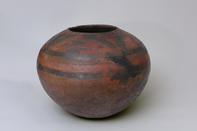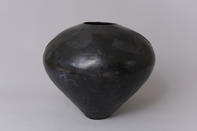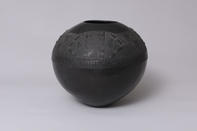
Different Clay Mixtures Make Different Pots
Venda Clay pot from Limpopo Province.
In some communities, women leave a bundle of twigs at the clay source when visiting for the first time or returning after a significant pause, thereby acknowledging this important natural resource as a gift from the ancestors. Red clays like those used by potters in Limpopo Province tend to be friable, often causing pots to flake after they’ve been fired. This tendency is probably caused by higher amounts of calcium and iron in the clay, leading to a decrease in plasticity, with greater shrinkage rates during drying and firing.
Coiled clay pot by Thandiwe Mabhengu Magwasa, one of several highly skilled potters from mPhabalane near Kranskop in present-day Kwazulu-Natal.
In present-day KwaZulu-Natal, potters tend to use sandy and organic-rich black clays in combination with red clays. Due to a higher smectite and mica content, black clays have greater plasticity. Once sifted, different mixtures of the red and black clays are used to achieve a balance between workability and plasticity, taking into account considerations such as the size and function of the vessels. Some mixtures include ground pottery shards (grog). Among Zulu-speaking potters, this practice has been recorded in the making of very large beer-brewing pots (izimbiza), while a potter in Limpopo Province claimed that it was a way for the spirit of the old pot to live on in the new one. Similar traditions of including ground shards from already fired pots are also found in other parts of Africa.
A pot produced by a female member of the talented Magwaza family from present-day Kwazulu-Natal.
The fairly recent introduction of plastic and metal hand-sieves means that many local rural potters no longer spend long hours removing the grass, mineral and stone debris that naturally occurs in clays. During the firing process, rubble-like inclusions like these tend to cause damage because they expand more rapidly than clay. In some areas, the efforts potters make to sift debris from clay has led to the production of lighter pots, ultimately boosting the external market for carefully crafted examples intended for display rather than use on a daily basis. Because pots like these have comparatively thin walls, breakages can be minimised by cradling them in the palms of the hand rather than lifting them, as traditionalists often do with one hand inserted into the mouth of the vessel when, on ritual occasion, these vessels are carried to be filled or refilled with beer.
By Professor Sandra Klopper





